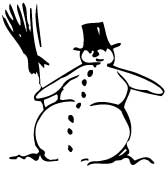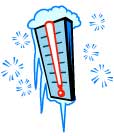Not Just for Kids
 Snow Show
Snow Show
We’re having a snowy, blowy winter in Maryland this year.
With so much snow fun to be had, do you ever wonder …
What makes snow?
When the temperature at cloud level is at freezing or below and the clouds are full of as much moisture as they can hold, look out for snow. Ice crystals form on tiny pieces of dust as water vapor condenses, and partially melted crystals cling together to form snowflakes.
Why do all snowflakes have six sides?
The six-sided shape of the ice crystal comes from the shape and bonding of the water molecules. If there’s very little wind, you may be able to see the intricate patterns of the snowflakes clearly with your very eyes as they land on your mitten and coat sleeves.
 Try this:
Try this:
Catch some snow. Chill a dark sheet of construction paper outside or in the freezer. Catch some flakes on it and examine them with a magnifying glass. To make permanent impressions of snowflakes, chill some non-aerosol hair spray and a pane of glass. Spray the glass and take it outside to collect snow. Bring the glass indoors and allow it to dry at room temperature for about 15 minutes. You’ll have beautiful snow pictures.
Wilson Bentley of Vermont was a self-taught scientist who spent his life photographing snowflakes around the turn of the 20th century. Read about him in Snowflake Bentley by Jacqueline Briggs Martin.
What else can you do in the snow?
- ‘Wet’ snow forms when warmer temperatures cause the falling flakes to clump together. This is good snow for making snowpeople, snowballs and snow forts.
 ‘Dry’ snow forms when the air temperature is very cold and the flakes are smaller and harder. What can you do then? Make snow angels, stay inside and draw snow scenes or whip up some snow cream.
‘Dry’ snow forms when the air temperature is very cold and the flakes are smaller and harder. What can you do then? Make snow angels, stay inside and draw snow scenes or whip up some snow cream.
- Snow cream:
Scoop clean snow into a bowl. Add some drops of vanilla extract, a bit of granulated sugar and some milk or cream for a snow slushy. You might need a straw to ‘eat’ it.
This Week’s Kids’ Stuff
January 31
Babies Don’t Have Hair?
Kids of all ages make a hairy craft as you enjoy the humorous family story, My Sister’s Hair. 10am @ Barnes & Noble, Harbour Center, Solomons Island Rd., Annapolis: 410/573-1115.
February 1
Slumber in the Shadows
Kids of all ages take a hike and see where groundhogs, chipmunks and bats go for their long winter’s nap. 1-3pm @ Jug Bay Wetlands Sanctuary, Wrighton Rd., Lothian. $1.50; rsvp: 410/741-9330 • www.jugbay.org.
February 3
End the Day with a Book
Preschoolers and parents (or caregivers) enjoy picture books, music activities and fingerplays. 7pm @ Eastport-Annapolis Public Library, Hillsmere Dr.: 410/222-1770.
February 4
In Search of Bugs
Kids 3-5 discover where bugs and other creatures hide in the winter. Bundle up and pack a sandwich. Parents welcomed. 10:30am-noon @ King’s Landing Park, King’s Landing Rd., Huntingtown. $3 w/discounts; RSVP: 410/535-5327.
Listen with Both Ears, Speak with One Voice
Kids of all ages join and listen to fellow youth recite African American poetry in celebration of Black History Month. 6:30pm @ Prince Frederick Library: 410/535-0291 • www.calvert.lib.md.us.

 Snow Show
Snow Show Try this:
Try this: ‘Dry’ snow forms when the air temperature is very cold and the flakes are smaller and harder. What can you do then? Make snow angels, stay inside and draw snow scenes or whip up some snow cream.
‘Dry’ snow forms when the air temperature is very cold and the flakes are smaller and harder. What can you do then? Make snow angels, stay inside and draw snow scenes or whip up some snow cream.